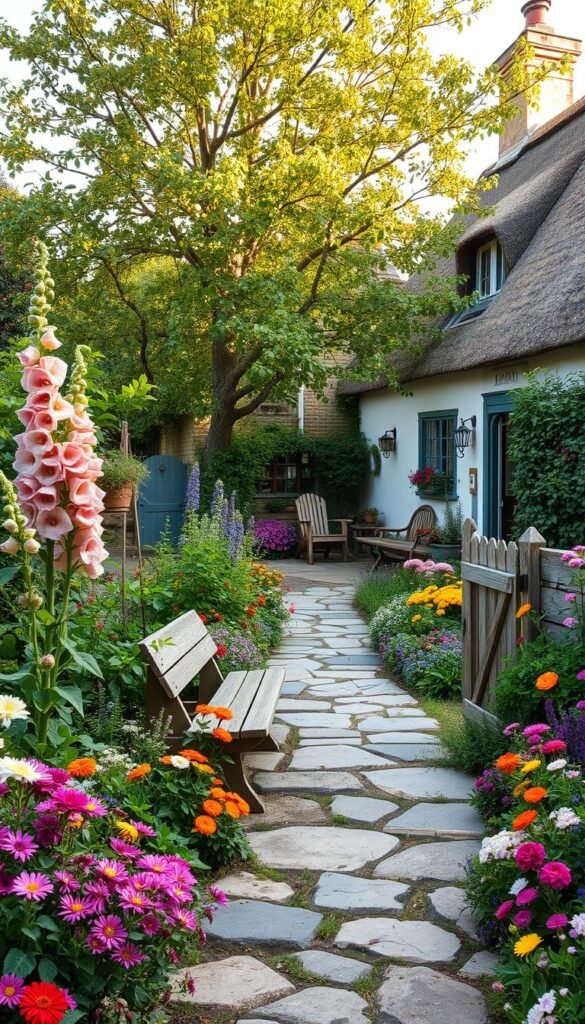Imagine stepping into a vibrant sanctuary where flowers spill over weathered stone walls and winding paths invite exploration. This relaxed style, rooted in English history, began as humble plots for growing food and medicine. Over centuries, it blossomed into a beloved aesthetic celebrating nature’s spontaneity. Today’s version mixes practical elements with playful details, offering a refreshing escape from manicured landscapes.
What makes this approach special? It thrives on personality over perfection. Unlike formal arrangements, plants grow in joyful clusters – think roses tangling with herbs or daisies dancing beside vegetables. For inspiration on mixing textures and colors, explore these creative planting combinations that attract pollinators while delighting the senses.
The magic lies in balancing three core components: lush greenery, meandering walkways, and cozy nooks. These elements work together to create zones for tending blooms or sipping morning tea. Worn benches under climbing vines or a rustic arbor draped in clematis add character without demanding precise symmetry.
Your space becomes a living canvas that shifts with the seasons. Start by observing sunlight patterns and soil conditions, then layer in plants that thrive in your region. Remember – this style adapts effortlessly, whether you’re working with a balcony or backyard. Discover more ways to blend functionality with whimsy in your personal oasis.
At its heart, this approach invites you to embrace nature’s rhythm. Let feathery grasses sway beside bold sunflowers, and allow stone pathways to develop a mossy patina. Your outdoor haven will evolve into a unique reflection of your connection to the earth – imperfect, alive, and endlessly surprising.
Embracing the Cottage Garden Charm
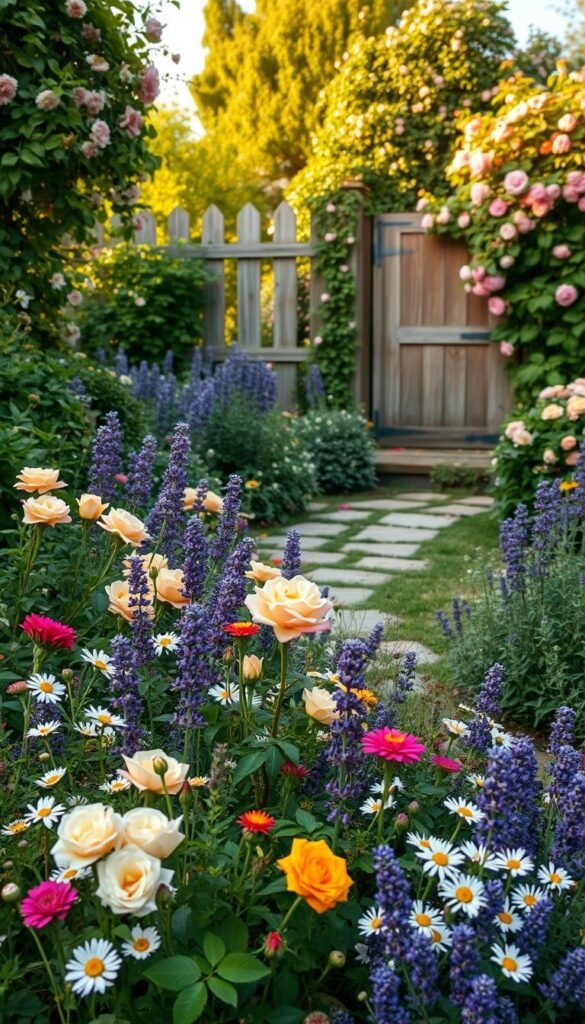
Picture a tapestry of blooms where hollyhocks stand sentinel over clusters of lavender and thyme. This living mosaic captures the essence of traditional cottage gardens, where structure meets serendipity in perfect harmony.
Characteristics of a Traditional Cottage Garden
Dense groupings of flowers and herbs create rhythmic patterns that guide the eye. You’ll notice repetition in color palettes – soft pinks echoed in roses and foxgloves, or sunny yellows bouncing between coreopsis and marigolds. Three-key strategies define this approach:
| Traditional Element | Modern Equivalent | Impact |
|---|---|---|
| Mixed-height plantings | Uniform shrubs | Adds depth |
| Self-seeding varieties | Controlled hybrids | Encourages spontaneity |
| Weathered materials | Polished finishes | Enhances rustic charm |
The Allure of Informal, Wild Plantings
What appears haphazard actually follows nature’s blueprint. Tall delphiniums frame shorter nasturtiums that tumble onto gravel walkways. This layered effect creates habitats for swallowtail butterflies and hummingbirds.
Vintage touches like iron focal points anchor the space without stifling growth. A chipped birdbath becomes a centerpiece, while clematis winds through an aged trellis. Your space feels curated yet carefree – a true old-fashioned cottage garden revival.
Small Cottage Garden Design Layout: Balancing Plants, Paths, and Seating
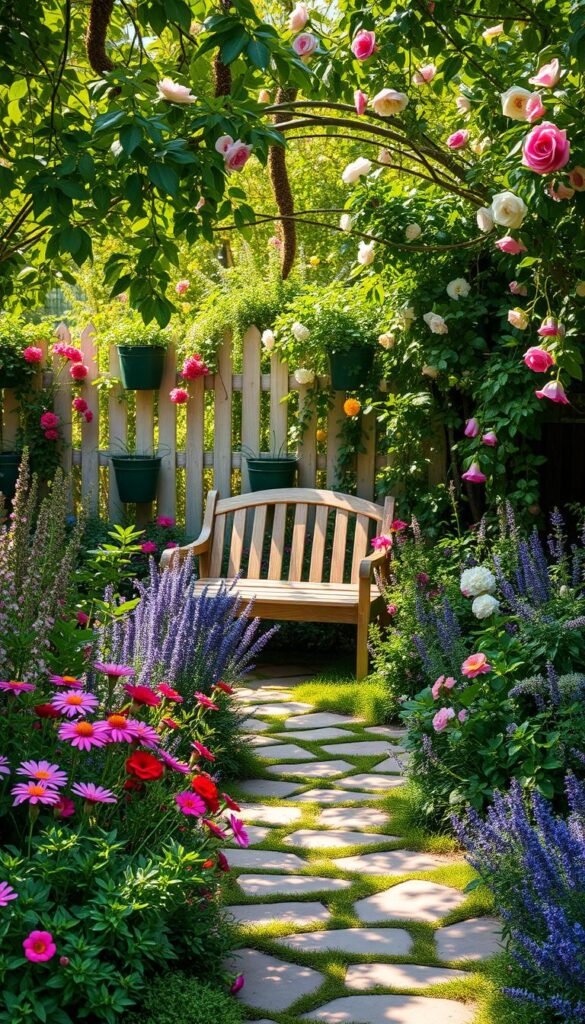
Creating a personalized retreat begins with thoughtful planning that reflects your unique vision. Start by assessing how you’ll use your outdoor haven – will it nourish your kitchen, soothe your spirit, or dazzle with seasonal color? This clarity helps transform even compact plots into multifunctional escapes.
Mapping Your Space and Defining Your Priorities
Jot down your must-haves before sketching. Do fragrant herbs for teas top your list? Maybe cutting flowers for vases or buzzing pollinators? These decisions shape your plant choices and flow. Grab paper to draft swooping walkways that curve around future planting zones, creating natural pauses where beauty unfolds.
| Path Material | Aesthetic Appeal | Maintenance Level | Plant-Friendly |
|---|---|---|---|
| Flagstone | Timeless texture | Low | High |
| Brick | Rustic charm | Moderate | Medium |
| Gravel | Crunchy casual | High | Low |
| Wood Chips | Natural look | Annual refresh | Medium |
Integrating Paths Seamlessly with Lush Plantings
Let greenery soften walkway edges for that lived-in magic. Low-growing thyme releases fragrance when brushed, while billowing catmint blurs boundaries between beds and stepping stones. Place a weathered bench where two paths meet – perfect for admiring sunset-lit blooms.
Follow the “ground-up” approach when planting. Tuck petite violas near walkways, mid-height daisies behind them, and towering sunflowers as backdrops. This tiered effect adds depth while keeping favorite blooms at eye level. Your routes become living galleries that change with each season’s stars.
Creative Planting Strategies and Seasonal Blooms
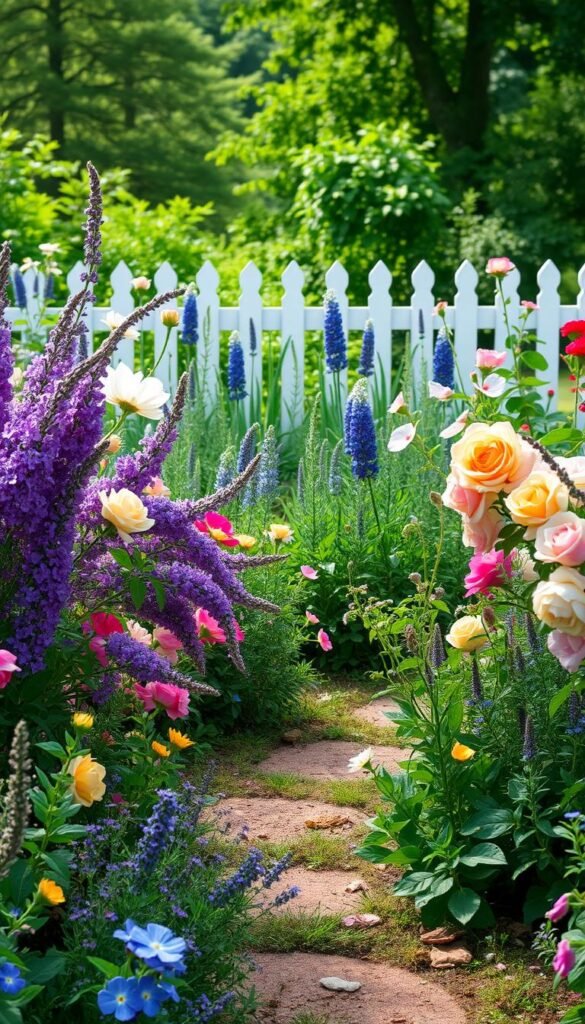
Envision a kaleidoscope of colors where every plant tells a story. Strategic combinations of cottage garden flowers, aromatic herbs, and productive vegetables create dynamic layers that shift with nature’s calendar. This approach transforms your space into a living scrapbook of textures and fragrances.
Selecting Cottage Garden Favorites: Flowers, Herbs, and Vegetables
Start with towering perennials like foxgloves and hollyhocks – nature’s skyscrapers that anchor your design. Pair them with fragrant herbs like rosemary and lemon balm, whose silvery leaves contrast beautifully with vibrant petals. Edible stars like cherry tomatoes and nasturtiums add pops of color while filling your salad bowl.
Consider these winning combinations:
- Sunflowers backdropping purple coneflowers
- Lavender bordering rainbow chard
- Climbing beans weaving through clematis vines
Tips for Achieving Year-Round Visual Interest
Keep your space lively through all seasons with this simple formula: 30% evergreens, 40% perennials, 30% annuals. Spring bulbs emerge through winter’s ornamental grasses, while summer’s zinnias hand the baton to autumn asters. For compact spaces, try container arrangements that rotate with the weather.
Pro tip: Let self-seeding cosmos and calendula fill bare spots naturally. Their cheerful blooms create that coveted “organized chaos” look while reducing replanting work. Your garden becomes a living calendar, marking time through petals and foliage.
Designing Functional Paths and Inviting Seating Areas
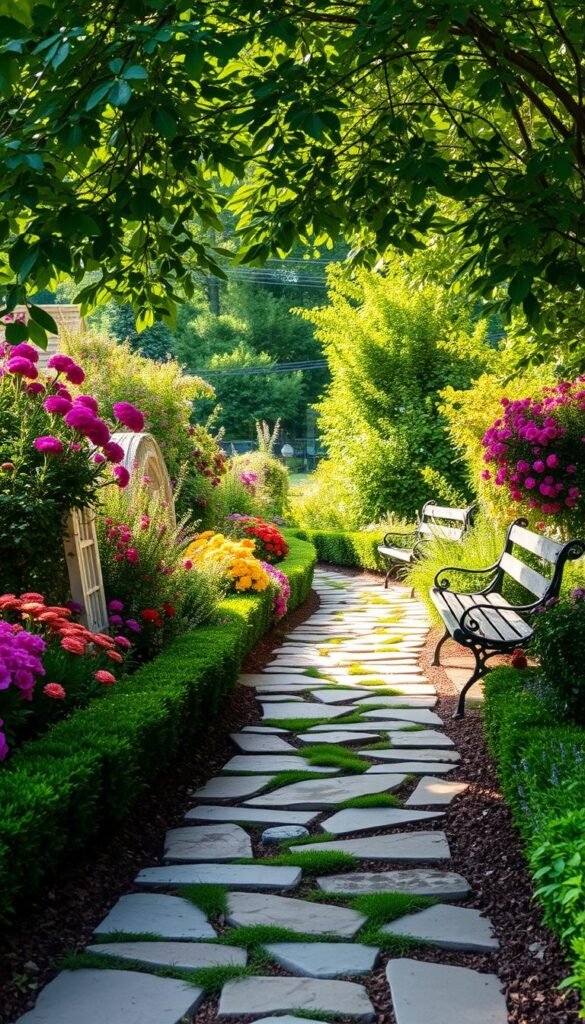
Meandering trails and welcoming nooks transform outdoor spaces into living storybooks. These elements guide visitors through blooming wonders while offering spots to pause and soak in nature’s theater.
Curved Paths Using Natural Materials
Choose materials that age gracefully, like irregular flagstones or reclaimed bricks. A width of 18-24 inches lets plants cascade over edges while maintaining walkability. Stepping stones through flower beds create hidden routes that feel discovered rather than planned.
| Material | Charm Factor | Durability |
|---|---|---|
| Flagstone | Rustic elegance | Decades |
| Gravel | Crunchy texture | 5-7 years |
| Recycled brick | Vintage appeal | Lifetime |
Cozy Seating Arrangements to Enhance Outdoor Enjoyment
Position benches where morning light filters through climbing roses or evening scents from jasmine drift by. Use trellises draped with sweet peas to frame sitting spots, blending privacy with panorama views.
Opt for furniture that weathers beautifully – think wrought iron bistro sets or cedar benches. Overhead structures like vine-covered pergolas add vertical interest while casting dappled shade. These features turn corners of your yard into destinations for relaxation or lively gatherings.
Maintaining Your Garden with Ease and Style
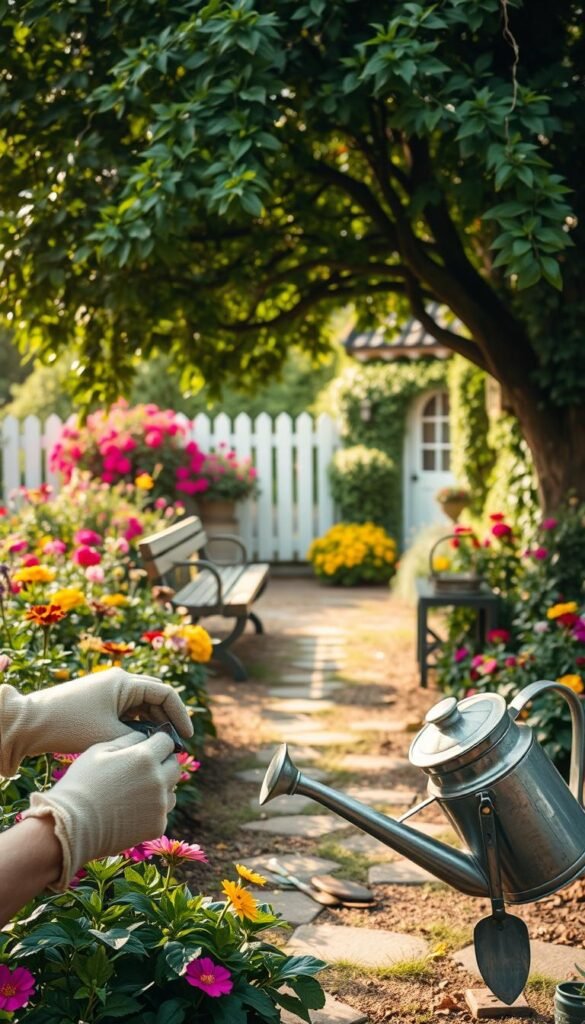
A thriving garden grows from attentive care that works with nature rather than against it. Simple systems and smart habits keep your space flourishing while preserving its wild charm. Let’s explore practical strategies to minimize chores while maximizing beauty.
Smart Watering, Soil Care, and Mulching Techniques
Healthy soil is your garden’s secret weapon. Test your earth every few years to adjust pH levels, then enrich it with compost or aged manure. A 2-inch layer of organic mulch does triple duty: locking in moisture, blocking weeds, and feeding nutrients slowly.
| Mulch Type | Benefits | Longevity |
|---|---|---|
| Straw | Lightweight, weed suppression | 1 season |
| Wood Chips | Soil insulation, decorative | 2-3 years |
| Shredded Leaves | Free nutrients, earthworm food | 6-8 months |
Install drip irrigation lines early in the season. These systems cut water use by 50% compared to sprinklers while keeping leaves dry – perfect for preventing mildew on roses or tomatoes.
Natural Pest, Weed Control, and Low-Maintenance Tips
Invite nature’s pest patrol by planting nectar-rich flowers for bees and ladybugs. When aphids appear, spray leaves with diluted neem oil at dusk. For persistent weeds, pull them after rain when roots slip out easily.
Refresh your seasonal care routine by deadheading spent blooms weekly. Divide overgrown perennials every 3-4 years to rejuvenate plants and share extras with neighbors. Embrace self-seeding annuals like poppies that fill gaps with cheerful volunteers.
Remember – a slightly wild look is part of the charm. Focus efforts on key areas like seating spots, then let other zones grow freely. Your sanctuary will reward you with endless surprises and year-round delight.
Your Journey to
As the seasons turn, your outdoor haven becomes a living diary of growth and discovery. Each sprouting seed and blooming flower mirrors your evolving connection with the earth’s rhythms. This process isn’t about instant perfection – it’s about celebrating progress over precision as you learn to read nature’s subtle cues.
Embrace moments when unexpected volunteers like poppies or cosmos pop up between planned plantings. These happy accidents add character while teaching adaptability. Keep a journal to track which combinations thrive in your microclimate, creating a personalized guide for future seasons.
Remember to pause often – sip tea surrounded by buzzing pollinators or watch twilight transform petals into silhouettes. These experiences deepen your appreciation for life’s fleeting beauty. Your space becomes more than plants and pathways; it evolves into a testament to patience, creativity, and joyful experimentation.
As you continue nurturing your natural retreat, let curiosity be your compass. Swap cuttings with fellow enthusiasts, try new heirloom varieties, or add handmade touches that reflect your story. With each choice, you’re crafting an ever-changing masterpiece that grows as vibrantly as your skills and passion.

